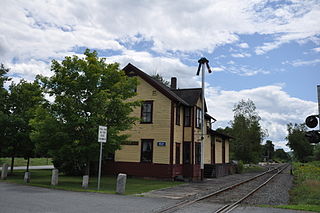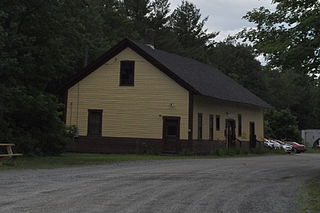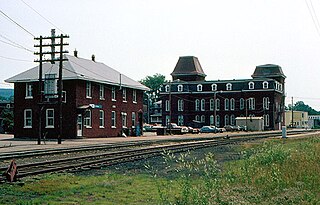
The Portland & Ogdensburg Railroad was a railroad planned to connect Portland, Maine to Ogdensburg, New York. The plan failed, and in 1880 the Vermont section was reorganized and leased by the Boston & Lowell Railroad. In 1886, the Maine and New Hampshire section was reorganized as the Portland & Ogdensburg Railway. That part was leased to the Maine Central Railroad in 1888, and in 1912 the Maine Central leased the eastern part of the Vermont section from the Boston & Maine Railroad, the successor to the B&L.

The Central Vermont Railway Depot is a historic former train station at Depot Square in the village of Northfield, Vermont. Built in 1852, it is believed to be the oldest surviving railroad station in the state. It was listed on the National Register of Historic Places in 1975.

Burlington Union Station is a train station and office building located in downtown Burlington, Vermont, United States. It is the northern terminal of the Amtrak Ethan Allen Express service. A single side platform on the west side of the station serves Vermont Railway excursion trains and Amtrak trains. The symmetrical Beaux Arts building, built of buff brick with limestone and granite trim, has a central pilaster over two entrances. The main building is divided for use by a variety of tenants.

Rouses Point station is an Amtrak intercity train station in Rouses Point, New York, served by the single daily round trip of the Adirondack. The station building is a former Delaware and Hudson Railway constructed in 1889, with a one low-level side platform on the east side of the track. It was added to the National Register of Historic Places in 2005 as Rouses Point Railroad Station.

Oxford station was a historic train station at South Elm and West Spring Streets in Oxford, Ohio. Oxford first received railroad service in the 1850s, when a line connecting the Chicago and Cincinnati rail networks was completed through the city. The original station was replaced by a larger building in 1895. Before the rise of the automobile, the station's passenger services brought students to and from Oxford's multiple colleges, including Miami University, and its freight services shipped local agricultural products to their markets. A building known as the Junction House, located across the street from the depot, was built in 1860 and is closely associated with the railroad. Originally a grocery store, it became a hotel and tavern in 1868; while a local temperance movement closed the tavern in the 1870s, it remained a hotel until 1905 and is now an apartment building.
The St. Johnsbury and Lamoille County Railroad (StJ&LC) was a railroad located in northern Vermont. It provided service to rural parts of the state for over a century, until track deterioration and flood damage made the line unusable and uneconomical to repair, which forced the line to close in 1995. Vermont is in the process of converting the roughly 96-mile route from St. Johnsbury to Swanton into a rail trail, known as the Lamoille Valley Rail Trail. Once completed it will be the longest rail trail in New England.

The Mountain Division is a railroad line that was once owned and operated by the Maine Central Railroad (MEC). It stretches from Portland, Maine on the Atlantic Ocean, through the Western Maine Mountains and White Mountains of New Hampshire, ending at St. Johnsbury, Vermont in the Northeast Kingdom. The line was abandoned in 1983 by MEC's successor, Guilford Transportation Industries (GTI). Guilford retained a stub between Portland and Westbrook. A section in New Hampshire remains in use by heritage railway Conway Scenic Railroad.

The Mathewson Block is a historic commercial building at 101 Main Street in the center of Lyndonville, Vermont. Built in 1869, it was the first brick commercial building erected in Lyndonville, which was founded in 1866. It was listed on the National Register of Historic Places in 1999.

The Fisher Covered Railroad Bridge is a covered bridge in Wolcott, Vermont. Built in 1908, it originally carried the St. Johnsbury and Lamoille County Railroad line over the Lamoille River. Now closed, it was the last covered bridge in Vermont to carry railroad traffic, and is a rare surviving example in the state of a double Town lattice truss. It was listed on the National Register of Historic Places in 1974.

The Bellows Falls Co-operative Creamery Complex is a historic industrial property in Bellows Falls, Vermont. Developed over a period of about 40 years beginning c. 1906, the complex, with two surviving buildings, it represents one of Vermont's largest commercial enterprises of the period. The property, located on the eastern side of Bellows Falls Island, was listed on the National Register of Historic Places in 1990.

Bennington station is a historic former railroad depot at 150 Depot Street in downtown Bennington, Vermont. Built in 1897-98 by the Bennington and Rutland Railroad, it is the only Richardsonian Romanesque railroad station in the state of Vermont. It was listed on the National Register of Historic Places in 1988 as Bennington Railroad Station, and since then housed a restaurant, which closed in 2018. It now is an office space for MSK Engineering and Design and Goldstone Architecture.
The Morrisville Depot located at 10 Depot Street in Morrisville, Vermont, is a decommissioned historic train station. Built in 1872 to serve the Portland and Ogdensburg Railway, the depot was known as the most important train station for the Vermont lumber industry, for its decorative architectural ornament, and for housing the headquarters of the St. Johnsbury and Lamoille County Railroad from 1959 to the early 1970s. It was subsequently converted into a restaurant. The Morrisville Depot was added to the National Register of Historic Places in 1982 as building #15 in the Morrisville Historic District.

The Ely Railroad Depot is a historic railroad station at Ely Road and Old Route 5 in Fairlee, Vermont. Built in 1900 by the Boston and Maine Railroad, it is a well-preserved rural station, designed to house the stationmaster as well as providing station facilities. It was listed on the National Register of Historic Places in 1994.

The Fairlee Railroad Depot is a historic railroad station at 320 United States Route 5 in the village center of Fairlee, Vermont. Built in 1848 and used in active service until 1972, it is one of the few surviving first-generation railroad station buildings in the state. Now used as a retail space, it was listed on the National Register of Historic Places in 1998.

The Central Vermont Railroad Headquarters is a complex of railroad-related buildings and infrastructure in the city of St. Albans, Vermont. Developed between the 1860s and 1920s by the Central Vermont Railroad (CVR), the complex is the largest assemblage of railroad-related buildings in Vermont. Located between Catherine and Pine Streets on either side of Lake Street, it was listed on the National Register of Historic Places in 1974. Many of the buildings are no longer used for railroad functions, but the former Central Vermont Railway Office now houses the offices of the New England Central Railroad, and the present Amtrak station uses a former CVR building.

The Swanton Covered Railroad Bridge was a covered bridge in Swanton, Vermont. Built in 1898, it carried the St. Johnsbury and Lamoille County Railroad across the Missisquoi River just west of Swanton village. It was destroyed by fire in 1987, and its site is now occupied by the former West Milton Bridge. The bridge was listed on the National Register of Historic Places in 1973, and has not been delisted despite its destruction.

The Railroad Street Bridge is a historic Pratt through truss bridge, carrying Railroad Street across the Lamoille River in Johnson, Vermont. It was built in 1928, after the state's devastating 1927 floods, and is one of its few surviving Pratt through truss bridges. It was listed on the National Register of Historic Places in 2007 as Bridge 6.

The Greensboro Depot is a historic railroad station on Main Street in the village of Greensboro Bend, Vermont. Built about 1872 by the Portland and Ogdensburg Railroad, it is a well-preserved example of that railroad's early station designs, and a reminder of the village's historic association with the railroad. It was listed on the National Register of Historic Places in 1975.

The Railroad Street Historic District encompasses a cluster of commercial and railroad-related buildings at the traditional late 19th-century heart of St. Johnsbury, Vermont. It includes five commercial buildings and the town's 1883 union depot, and is reflective of the town's importance as a major railroad junction in northern New England. The district was listed on the National Register of Historic Places in 1974. It was subsumed by the larger St. Johnsbury Historic District in 1980.
East Hardwick is an unincorporated village in the town of Hardwick, Vermont, United States. It is part of what is known as the Northeast Kingdom (NEK) of Vermont. The community is located on the Lamoille River and along Vermont Route 16, 16 miles (26 km) west-northwest of St. Johnsbury. East Hardwick has a post office with ZIP code 05836, which opened on October 10, 1810. According to a 1937 WPA Federal Writers Project Guidebook, East Hardwick is a "side hill village spilling from the level of a plateau down a sharp incline in the valley of the Lamoille. It is surrounded by rich farm lands, Maple groves and forests."




















